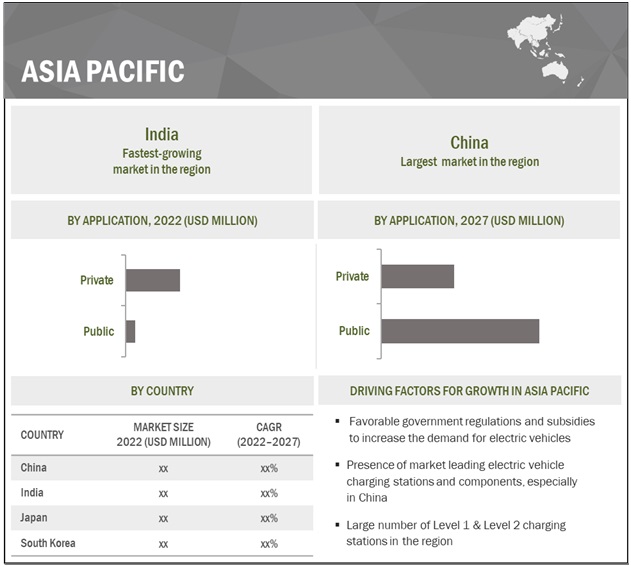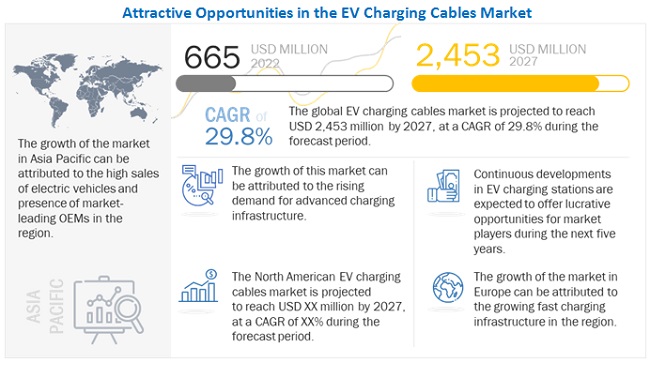Report:
EV Charging Cables Market by Power Supply (AC and DC), Application (Private Charging and Public Charging), Length (2-5 Meters, 6-10 Meters, and >10 Meters), Shape (Straight and Coiled), Mode, Charging Level, Diameter and Region – Global Forecast to 2027
The global EV charging cables market is projected to grow at a CAGR of 29.8%, to reach USD 2,453 million by 2027 from an estimated USD 665 million in 2022. The market growth is driven factors such as increasing adoption of electric vehicles worldwide, rapid growing installation of EV charging stations across the globe and increasing demand for fast charging cables would drive the growth of the market.
Market Dynamics of EV Charging Cables :

How increasing adoption of electric vehicles will boost the market?
In 2021, the world saw a over 108% growth with around 6.6 million EV sales as compared to 2020. In October 2021, GM announced plans to invest USD 35 billion to develop and achieve more than one million EV sales and other technology by 2025. The company plans to go all electric by 2035. Ford also plans to increase its EV production capacity to 600,000 per annum by 2023 as announced in November 2021. It plans to make 40% of its vehicle offerings electric by 2030. Similarly, Volkswagen announced plans to invest USD 86.3 billion to speed up its EV plans by 2030. Other companies like Tesla, Nissan, and BMW, among others, have also made significant developments and plans for the upcoming EV demand in the coming 5-10 years. These investments and policies are expected to boost the growth of the electric vehicle charging station market during the next decade, in turn driving the market for EV charging cables.
Why wireless charging is threat to the growth of the market?
Wireless charging technology can charge a vehicle wirelessly while it is in static or in motion. New products for wireless charging of electric vehicles have been developed by various companies such as Robert Bosch and WiTricity. Several countries such as the US, Norway, Sweden and the UK among others have initiated pilot projects for wireless charging roads. Since wireless charging offers much higher flexibility and convenience as compared to wired charging, it represents a prominent threat to charging cables. Additionally, wireless charging is regarded as safer than wired charging as it virtually eliminates the risk of electric shocks. Thus, growing development of wireless charging technology may hamper the charging cable market growth.
How R&D in charging cables can drive the market ?
The cable manufacturers are into developing advance ev charging cables to cater the demand for high speed charging. The usual charging voltages for DC charging is 400 V to 480 V and can charge upto about 50kW. Many companies are into research and development such as Phoenix contact have developed an high power EV charging cable that can fast charge vehicles and equipped with advance cooling system which consist of water-glycol mixture. Technological advancements have also led to changes in the charging interface. For example, a lighting function is incorporated in EV charging cables by LEONI AG, which illuminates in dark and avoids tripping over the cable. This type advancements will drive the market for EV charging cables in future.
By Shape: Straight segment is expected to hold the largest market share during the forecast period
Straight cables are generally used when multiple stations are situated within a short distance. These cables are cheaper than coiled cables but are less durable. The current carrying capacity of these cables varies with the thickness of the cable. As most of the charging stations are equipped with Type 1 (J1772) connectors, straight cables are commonly used for electric vehicle charging. This type of EV cable has a capacity of 7.4 kW in a single phase. Car brands that use a Type 1 EV straight charging cable include BMW, Nissan, Mitsubishi, Toyota, Volvo, Audi, and Mercedes Benz. EV cables must have a small diameter to make them easy to handle, but this also exposes them to excessive heating. Hence, these cables are fitted with a liquid-cooling system. Type 1 AC charging cables that comply with SAE J1772/IEC 62196-2 standards are used in the US and Japan. Several critical components are considered for an effective cable design. These include an electrical conductor, an insulation material, and a connector. Asia Pacific is expected to be the largest market for straight cables during the forecast period. Most of the countries in this region are cost-sensitive markets. According to industry experts, straight cables can be up to 30% less expensive than coiled cables. Thus, straight cables are preferred over coiled cables as they are less expensive than coiled cables and are easy to handle. Apart from the cost, straight cables are easy for storage as well as lightweight and convenient for use. The majority of the public EV chargers installed in the region have straight-shaped cables as well.
By Mode: Mode 4 segment is estimated to be the fastest growing market during the forecast period
The mode 3 EV charging cable is a connector cable between the EV and charging station. In the European region, the type 2 plug is considered a standard. Charging facilities are most often attached with a type 2 socket in order to allow EVs to charge using type 1 and 2 plugs. Either a mode 3 EV charging cable (type 2-type 2) or mode 3 EV charging cable (type 2-type 1) is required to charge EVs.
Mode 3 charging includes the use of a dedicated charging station for EV charging. It provides shock protection against both AC as well as DC. In mode 3, the charging cable is provided with the charging facility, and the vehicle does not need an extra charging cable for charging.
Mode 3 cables are commonly used to charge an EV across the globe. These charging cables can connect the vehicle to a dedicated EV charging station installed in places such as offices, homes and residential locations, and commercial and public parking lots.
Asia Pacific is expected to account for the largest market size during the forecast period
The Asia Pacific region is expected to be the largest market for EV charging cables during the forecast period. The increasing adoption of electric vehicles in China and Japan is expected to drive the market. According to data published by the China Electric Vehicle Charging Infrastructure Promotion Alliance, the number of charging posts across the country reached over 2.61 million by the end of December 2021, representing year-on-year growth of around 70.1%. In 2021, a total of 936,000 charging piles (+193%) were newly built in China, including 340,000 public piles (+89.9% YoY) and 597,000 private ones (+323.9% YoY). The increasing development of charging stations will, in turn, boost the demand for EV charging cables. Most of the public charging stations in China install straight-shaped EV charging cables as these are easy to manufacture and exert less force compared to coiled-shaped EV charging cables.
Check the complete study here:
https://www.marketsandmarkets.com/Market-Reports/ev-charging-cable-market-71981137.html




